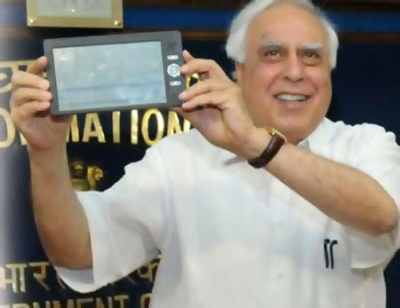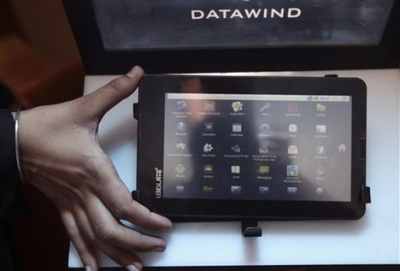 | « Back to article | Print this article |
All about Aakash's Chinese inheritance
Hardeep Singh Puri, India's Permanent Representative to the United Nations, had earlier announced that Aakash 2 will be showcased as an example of "frugal innovation" at the UN headquarters on November 28.
That pride of place for the world's cheapest tablet now appears doubtful, as questions are being raised on its 'Made in India' tag.
In an emailed response, Suneet Singh Tuli, CEO of Datawind, the maker of Aakash, did not exactly deny the 'Made in China' theory, while at the same time emphasising that Aakash 2 was assembled and programmed in India and that qualifies is as an Indian innovation.
Click NEXT to read further. . .
All about Aakash's Chinese inheritance
"We don't know what document proof is being shown or misinterpreted.
"We do not need to defend purchase of Chinese components or motherboards -- or collating the kits in China. Our position stays the same -- the final assembly and programming was done in India. No legal or contractual obligation is violated by doing so," he says.
For the first 10,000 units for IIT-Bombay, Datawind had the motherboards and kits manufactured in its Chinese subcontractor's facilities, says the company.
Devang Khakhar, director, IIT-Bombay, which had the responsibility of developing and testing the tablet, says: "As far as we are concerned, we have placed an order with a company that is based in India.
Click NEXT to read further. . .
All about Aakash's Chinese inheritance
"Now, how they outsource is neither in our control nor is it a part of the purchase order or agreement.
"They only have to give us the products to the specifications. We don't insist they be made in India."
Tuli says part of the work for Aakash 2 was outsourced to China because it has a better manufacturing ecosystem.
In its present form, the low-cost tablet has about 800 components from 60 vendors and Datawind had the boards made and tested in China for the initial stages of production. This will shift to India over time, he says.
Click NEXT to read further. . .
All about Aakash's Chinese inheritance
"We also had small tablet manufacturers kit together the parts of each unit (using motherboards, and touchscreens from Datawind's Montreal facility). The Chinese manufacturers source the components (including the ones we've designed) from our nominated subcontractors -- which then are brought to India for final assembly and programming," Tuli says in the email.
The much heralded Aakash project is part of India's Rs 4,612-crore (Rs 46.12-billion) National Mission on Education through Information & Communication Technology, launched in 2009, with an aim to eliminate digital illiteracy by distributing the tablets to students at subsidised rates.
Click NEXT to read further. . .
All about Aakash's Chinese inheritance
Under NME-ICT, the government aims to increase the "enrolment in higher education" and take delivery of education to "citizens' doorstep" through creation of a national digital knowledge repository which can be freely accessed by anyone and everyone over the internet.
To this effect, the human resource development ministry has allocated 60 per cent of its total budget to connect 400 universities and almost 20,000 colleges, across the country.
Under NME-ICT, colleges and universities are given 50 per cent subsidy for procuring Aakash devices, which could then be borrowed by financially weak students from the library just like books are borrowed at present.
Thus, doing away with the need for subsidy to poor students to buy the tablet.
Click NEXT to read further. . .
All about Aakash's Chinese inheritance
Last year, Kapil Sibal, Union HRD minister, unveiled the first version of Aakash, manufactured by Datawind that mostly received poor ratings for performance from experts.
After much delays, Datawind then introduced Aakash 2 tablet that sports a 7-inch touch screen with 800x480 pixels resolution and runs on an upgraded Android 4.0 operating system.
The tablet will be procured by the government at Rs 2,263 per unit and will be provided to students for a subsidised Rs 1,132.
While the government is subsidising the cost of the tablet, none of the Aakash 2 components is subsidised by the government to encourage local manufacturing.
Click NEXT to read further. . .
All about Aakash's Chinese inheritance
"There are no directions prescribed by the government for how or where Aakash 2 is to be manufactured. Thus, no legal or contractual obligation is violated by doing so," Tuli says.
Datawind further details that initial devices of Aakash 2 were assembled and programmed at its facilities in New Delhi and Amritsar.
"We finished this batch of 10,000 units and delivered them to IIT and will be starting another batch of 20,000 units for them in two weeks.
"The media is welcome to visit when we do this batch. We also have four partner manufacturers across India that will work on the deliveries to the government but we just couldn't get them started to assemble our Aakash 2 units in time, but they will start to ship early in December," he added.
Click NEXT to read further. . .
All about Aakash's Chinese inheritance
In the first phase, 100,000 tablets will be distributed by IIT-Bombay by early next year.
"All our tablets will be received by the end of this year. Then it is a matter of doing projects of various types, loading software, developing software and so on and so forth," explained Khakhar.
What's next for Aakash? Sources in HRD ministry say they are already thinking in terms of the next version of Aakash that will be based on a chip concept.
The efforts of the ministry are now directed in two directions: achieving the same functionality at a lower cost and added functionality at the same price.








